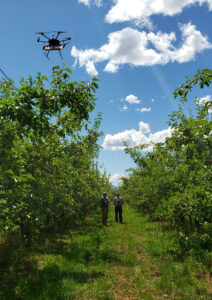Project Overview
Information Products
Commodities
- Fruits: apples
Practices
- Pest Management: biological control
Proposal abstract:
 Releasing by drone[/caption]
Releasing by drone[/caption]
Washington apple growers are experimenting with releasing natural enemies purchased from commercial insectaries. Lacewings releases, targeting aphids and mealybugs, are the most common. Aphid and mealybug organic control options are limited and damage from honeydew production alone can cause $400-$4,000/acre of yield loss. ≥25% of growers are conducting releases, spending $153/acre/year. The industry purchases $1M of natural enemies per year, with demand increasing annually, especially for releases by drone. Growers’ indicate that their biggest barrier to successful adoption is lack of best practice recommendations, not cost or perceived lack of efficacy. However, current recommendations are based on greenhouse use and are not well-matched to orchards, which greatly differ in climate, acreage, crop, and target pests. Therefore, this project addresses a need for scientifically-based recommendations on how to release lacewings in apple orchards. We will determine (1a) which release methods provide the most effective aphid and mealybug control by comparing life stages (releasing eggs or larvae), available species, and methods (sprinkled or hanging egg cards). We will compare the efficacy of the two commercially available species of lacewing, Chrysoperla rufilabris and Chrysoperla plorabunda (sold as “C. carnea”). We will conduct large plot tests of drone-released lacewings to determine (1b) if they are effective and to what extent release rates need to be increased for success compared to a ground release. For the most effective release method, we will (2) identify the release rate that best balances cost and pest control. Finally, we will (3) determine if and for how long residues of organic pesticides are harmful to lacewings, allowing for better integration of chemical and biocontrol tactics. To increase grower knowledge and adoption of release best practices, we will develop a “tailgate training kit” and a natural enemy releases webpage. The bilingual “Tailgate training kit” will be designed for managers to train crews, with a large flipchart and a plain language handout summary for in-field trainings on how to perform releases, and a pocket flipbook on identification and other key information for later reference. The natural enemy releases “how-to” webpage will host summaries of research findings, best practice recommendations, and four video tutorials on how to conduct releases (ground and drone), do quality control checks of lacewings received, and scout after release. A participatory research framework will be used to increase grower-to-grower information spread and adoption. Each grower-collaborator will host a field day, where they will discuss their experiences with releasing predators and where we will demonstrate release methods and scouting, in collaboration with insectary representatives. The grant team will conduct a half-day Natural Enemy Releases session, with a grower-collaborator panel discussion. At the end of the project, we will conduct a follow-up evaluation to capture producer adoption of new practices and the impacts on their farms. Increased adoption of and success with biocontrol releases will reduce grower expense on unsuccessful releases and decrease pesticide use. This will decrease harm to non-target organisms, pesticide environmental contamination, and farmer and community exposure to residues.
Project objectives from proposal:
Research Objectives
1. Determine which method of releasing lacewings results in the greatest establishment and pest control
a. Compare species, life stages, and cards versus loose eggs
b. Compare drone to ground releases at orchard-scale
2. Determine which lacewing release rate is most effective for aphid control
3. Determine the effects of organic pesticides on insectary-reared lacewings
a. Determine acute toxicity of organic pesticides to lacewings
b. Determine the duration that field-aged residues remain harmful
Education Objectives
1. Increase grower knowledge and adoption of natural enemy release best management practices:
80% of participants in trainings will gain new knowledge and 50% will plan to try natural enemy releases on their farms or alter how they are currently doing releases.
Activity A. Create a toolkit for growers to train their workforce on lacewing releases
Output: Toolkit
Activity B. Create a web-based resource that acts as a “one-stop shop” for information on release best practices
Output: Website
Activity C. Increase grower adoption of successful lacewing releases using a participatory research framework
Outputs: Advisory meetings, Field days, Intensive Session
2. Disseminate research results to other agricultural professionals and the general scientific community
Activity A. Scholarly outputs
Outputs: journal articles, conference presentations
Activity B. Additional grower and other agricultural professional outreach
Outputs: Fruit Matters articles, grower meeting presentations